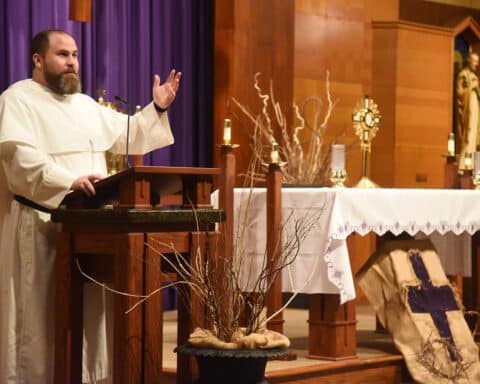When you walk into a Catholic church, what is the first thing you do? Here in the midst of the National Eucharistic Revival, with Christ’s real presence in the tabernacle of every Catholic Church in the world front of mind, you may have answered, “I genuflect.” And that, of course, is what you should do, but it’s not what you should do first. You most likely genuflect when you reach your pew, but take a few steps backward, to just inside the door of the sanctuary, and what did you do? You dipped your right hand into the font of holy water and made the sign of the cross.
Like genuflecting, we perform this action so frequently that we often do so without thinking about what it means. We shouldn’t, because just like the Penitential Rite at Mass, the signing of ourselves with holy water is meant to place us in the right mindset to “prepare ourselves to celebrate the sacred mysteries.” This seemingly trivial action should call to mind every time our baptism, and all that it both signified and effected. From the moment that our fingers touch that holy water through the moment when we receive the Eucharist, our participation in the sacraments of initiation — baptism, confirmation and holy Communion — is present to us once more.
Indeed, it is because of our baptism that we are able to receive the body and blood of Christ, to participate in the holy sacrifice offered once and for always on Mount Calvary on Good Friday, and made present to us again in every Eucharistic liturgy. We think most often, perhaps, of baptism as our entrance into the Church, into the Body of Christ, and it is that. But baptism does not make us a member of the Body of Christ the way that, say, an initiation ceremony may make us a member of a social club. For Christ was baptized, too, and his baptism and ours are one.
Baptized into Christ
When we think of the effects of baptism, first and foremost is the remission of Original Sin, and of any sins that we may have committed personally. Jesus, of course, was sinless, so his baptism in the Jordan at the hands of his cousin, St. John the Baptist, didn’t have that effect on him personally. Yet he was baptized, and not simply to provide an example or to sanctify the waters of baptism through his actions. His baptism was, as Pope Benedict XVI pointed out in “Jesus of Nazareth,” “an anticipation of the Cross,” of his death and resurrection — the very death and resurrection that we celebrate at every Eucharistic liturgy, and that, through our celebration, is made present to us once more.
At our baptism, we were baptized into Christ fully and completely, and thus we were baptized into his death and his resurrection. Every time we sign ourselves with holy water as we enter the sanctuary of our church to participate in the Eucharistic sacrifice, we should strive to call to mind this reality and to connect this action to the sacrifice on the altar. To become a member of the Body of Christ means to die to self and to rise in him, in the body that is blessed and broken on the altar of our church just as it was at the Last Supper on Holy Thursday and on the cross on Good Friday. This is our sacrifice, not just in the sense that we offer it along with the priest, but in the sense that we and the priest are members of the very body that we are offering to God the Father, the very body that Christ offered to his Father on the cross.
In baptism, we are made one with the Body of Christ; in holy Communion, we receive that same body, blood, soul and divinity into our own bodies. When our participation in the Body of Christ moves from being merely a teaching that we understand intellectually to an experience that captures our imagination and enlightens our understanding, then the real presence of Christ becomes not a subject for surveys but a lived reality that draws us back, again and again, to the altar where he accepts our sacrifice, sanctifies it and unites it to his, all in the worship of his Father, and ours.





